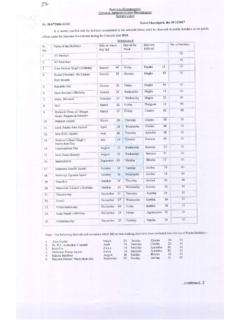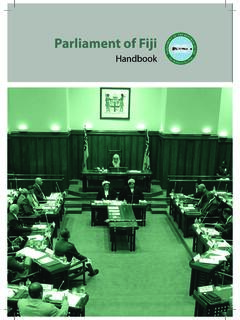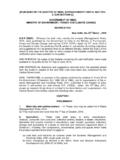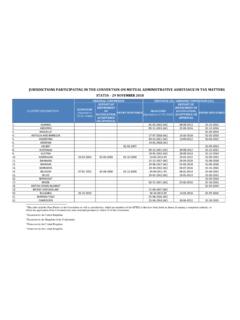Transcription of Hydrocortisone, Vitamin C and Thiamine for the Treatment ...
1 Accepted Manuscript hydrocortisone , Vitamin C and Thiamine for the Treatment of Severe Sepsis and Septic Shock: A Retrospective Before-After Study Paul E. Marik, MD, FCCM, FCCP, Vikramjit Khangoora, MD, Racquel Rivera, Pharm D, Michael H. Hooper, , MSc, John Catravas, PhD, FAHA, FCCP. PII: S0012-3692(16)62564-3. DOI: Reference: CHEST 847. To appear in: CHEST. Received Date: 7 october 2016 . Revised Date: 31 october 2016 . Accepted Date: 16 November 2016 . Please cite this article as: Marik PE, Khangoora V, Rivera R, Hooper MH, Catravas J, hydrocortisone , Vitamin C and Thiamine for the Treatment of Severe Sepsis and Septic Shock: A Retrospective Before- After Study, CHEST (2017), doi: This is a PDF file of an unedited manuscript that has been accepted for publication.
2 As a service to our customers we are providing this early version of the manuscript. The manuscript will undergo copyediting, typesetting, and review of the resulting proof before it is published in its final form. Please note that during the production process errors may be discovered which could affect the content, and all legal disclaimers that apply to the journal pertain. ACCEPTED MANUSCRIPT. REVISION 1. Title: hydrocortisone , Vitamin C and Thiamine for the Treatment of Severe Sepsis and Septic Shock: A Retrospective Before-After Study. Authors: Paul E. Marik, MD, FCCM, FCCP1. PT. Vikramjit Khangoora, MD1. Racquel Rivera, Pharm D2. Michael H. Hooper, , MSc1. John Catravas, PhD, FAHA, FCCP3,4. RI. Affiliations: 1 Divisionof Pulmonary and Critical Care Medicine SC.
3 Eastern Virginia Medical School, Norfolk, VA. 2 Department of Pharmacy U. Sentara Norfolk General Hospital, 600 Gresham Drive, Norfolk, VA. AN. 3 School of Medical Diagnostic & Translational Sciences, College of Health Sciences, Old Dominion University M. 4 Departments of Medicine and Physiological Sciences, Eastern Virginia Medical School, Norfolk, VA. D. Running Heading: Steroids, Vitamin C and Thiamine for sepsis TE. Word Count: 4077. EP. Key words: sepsis; septic shock; hydrocortisone ; corticosteroid; Vitamin C;. Thiamine C. AC. Version: Cure_sepsis_2016o Funding: None 1|Page ACCEPTED MANUSCRIPT. COI: None of the authors have a conflict of interest to declare. Date: october 30, 2016 . Address for Correspondence: PT. Paul E. Marik, MD, FCCM, FCCP. Professor of Medicine Chief, Pulmonary and Critical Care Medicine RI.
4 Eastern Virginia Medical School 825 Fairfax Ave, Suite 410. Norfolk, VA 23507. SC. U. AN. M. D. TE. C EP. AC. 2|Page ACCEPTED MANUSCRIPT. Abstract: Background: The global burden of sepsis is estimated as 15 to 19 million cases annually with a mortality rate approaching 60% in low income countries. PT. Methods: In this retrospective before-after clinical study, we compared the outcome and clinical course of consecutive septic patients treated with intravenous Vitamin C, RI. hydrocortisone and Thiamine during a 7-month period ( Treatment group) compared to a control group treated in our ICU during the preceding 7 months. The primary outcome was SC. hospital survival. A propensity score was generated to adjust the primary outcome. U. Findings: There were 47 patients in both Treatment and control groups with no significant AN.
5 Differences in baseline characteristics between the two groups. The hospital mortality was (4 of 47) in the Treatment group compared to (19 of 47) in the control group (p M. < ). The propensity adjusted odds of mortality in the patients treated with the Vitamin C protocol was (95% CI , p=002). The SOFA score decreased in all patients in D. the Treatment group with none developing progressive organ failure. Vasopressors were TE. weaned off all patients in the Treatment group, a mean of hours after starting EP. Treatment with Vitamin C protocol. The mean duration of vasopressor use was hours in the control group (p< ). C. Conclusion: Our results suggest that the early use of intravenous Vitamin C, together with AC. corticosteroids and Thiamine may prove to be effective in preventing progressive organ dysfunction including acute kidney injury and reducing the mortality of patients with severe sepsis and septic shock.
6 Additional studies are required to confirm these preliminary findings. 3|Page ACCEPTED MANUSCRIPT. The global burden of sepsis is substantial with an estimated 15 to 19 million cases per year; the vast majority of these cases occur in low income With more timely diagnosis and improvement in supportive care the 28-day mortality from sepsis in high income countries has declined to about 25%; however, the mortality rate from septic shock PT. remains as high as 50%. 2-5 Moreover, the mortality from sepsis and septic shock in low income countries is approximately 60%.6-8 In addition to short term mortality, septic RI. patients suffer from numerous short- and long-term complications with a reduced quality SC. of life and an increased risk of death up to five years following the acute Over the last 3 decades, over 100 phase II and phase III clinical trials have been performed testing U.
7 Various novel pharmacologic agents and therapeutic interventions in an attempt to AN. improve the outcome of patients with severe sepsis and septic shock; all of these efforts ultimately failed to produce a novel pharmacologic agent to directly target the M. pathophysiologic effects of severe sepsis. 12 New therapeutic approaches to sepsis are D. desperately required. To impact the global burden of sepsis these interventions should be TE. effective, cheap, safe and readily available. EP. We were recently confronted with three patients with fulminant sepsis who were almost certainly destined to die from overwhelming septic shock. Based on experimental C. and emerging clinical data, we decided to administer intravenous Vitamin C to these AC. patients as a life-saving Moderate-dose hydrocortisone was added for its theoretical synergistic benefit.
8 All three of these patients made a dramatic recovery and were discharged from the ICU within days with no residual organ dysfunction. Based on this experience and the reported safety and potential benefit of this therapeutic 4|Page ACCEPTED MANUSCRIPT. intervention, the combination of intravenous Vitamin C and corticosteroid became routinely used as adjunctive therapy for the Treatment of severe sepsis and septic shock in our ICU. Patents with sepsis predictably have very low serum Vitamin C levels, which can only be corrected with intravenous Vitamin C in a dose of more than 3gm per day. 16;18;19. PT. Based on published clinical data, Vitamin C pharmacokinetic modeling as well as the package insert, we decided to administer 6gm Vitamin C per day divided in 4 equal RI.
9 Doses. 16;18-23 This dosage is devoid of any reported complications or side effects. Dosages SC. as high as 100-150gm have been safely administered to patients with burns and ;24;25 hydrocortisone was dosed according to the consensus guidelines of the U. American College of Critical Care Intravenous Thiamine ( Vitamin B1) was added AN. to the Vitamin C protocol (see discussion section for rationale).27. M. D. TE. C EP. AC. 5|Page ACCEPTED MANUSCRIPT. Methods: This study was an Electronic Health Record (EHR) based retrospective before-after clinical The study was approved by our Institutional Review Board (#16-08-WC- PT. 0179) and the Sentara Health System Office of Research (16-08-SRC-88). This study was conducted at Sentara Norfolk General Hospital, a tertiary care referral hospital affiliated RI.
10 With Eastern Virginia Medical School (EVMS) and the only tertiary care facility in the SC. Hampton Roads area serving a population of approximately million people. Between January 2016 and July 2016 , consecutive patients admitted to the EVMS Critical Care U. Medicine service in the General ICU at Sentara Norfolk General Hospital with a primary AN. diagnosis of severe sepsis or septic shock and a procalcitonin (PCT) 2ng/ml were treated with intravenous hydrocortisone , Vitamin C and Thiamine ( Vitamin C protocol) within 24. M. hours of ICU admission ( Treatment group). PCT is routinely measured in our hospital as a D. screening tool for sepsis and to follow the evolution of the disease. 29-32 PCT is measured in TE. our laboratory using the VIDAS BRAHMS PCT assay, a one-step immunoassay sandwich method with final fluorescent detection (BioMerieux, Inc.)





